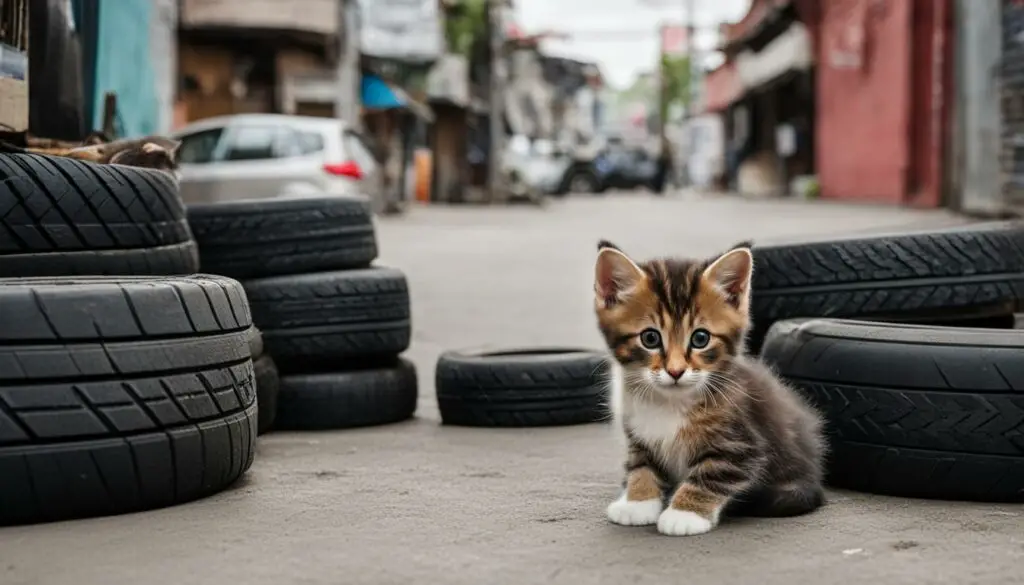Are you a cat lover on the lookout for adorable stray kittens? You’re in luck! There are numerous common places where you can find these cute little furballs. However, before we dive into that, it’s important to note that it’s generally best to leave kittens with their mother if possible. But in certain circumstances, intervention may be necessary to ensure their well-being. In this article, I’ll guide you through the common places to find stray kittens and provide helpful tips on what to do when you come across them.
Key Takeaways:
- Knowing common places to find stray kittens can help you locate them and provide them with care.
- It’s generally best to leave kittens with their mother, as she is the best caregiver for them.
- If intervention is necessary, seek help from animal welfare organizations to ensure the kittens’ well-being.
- Education and prevention are crucial in reducing the number of stray kittens in the future.
- Remember to always approach stray kittens with kindness and gentle care.
Leave Them BeTM: Allowing Mother Cats to Care for Kittens
When you come across a group of kittens outdoors, it’s important to resist the urge to intervene right away. In most cases, the mother cat is nearby and is the best caregiver for her kittens. Removing kittens younger than 8 weeks old from their mother can be detrimental to their health and development. It’s crucial to understand the significance of leaving them with their mother, as she is instinctively equipped to provide the care they need.
Kittens rely on their mother for warmth, nutrition, and socialization. She teaches them important skills, such as grooming and using the litter box. By allowing the mother cat to care for her kittens in their outdoor home, you are giving them the best chance at survival and a healthy upbringing. It is a natural process that should not be disrupted unless there are exceptional circumstances.
“The bond between a mother cat and her kittens is incredibly strong. She will do everything she can to protect and care for them. In most cases, it is best to trust her instincts and leave the kittens in her care.”
Providing the mother cat with a secure outdoor shelter and regular food and water can help make her more comfortable as she cares for her kittens. Keeping a respectful distance and observing from afar can give you the opportunity to make sure the kittens are thriving and the mother is attentive to their needs. Remember, mother cats are resourceful and will move their kittens if they feel threatened or unsafe, so give them the space and privacy they need.
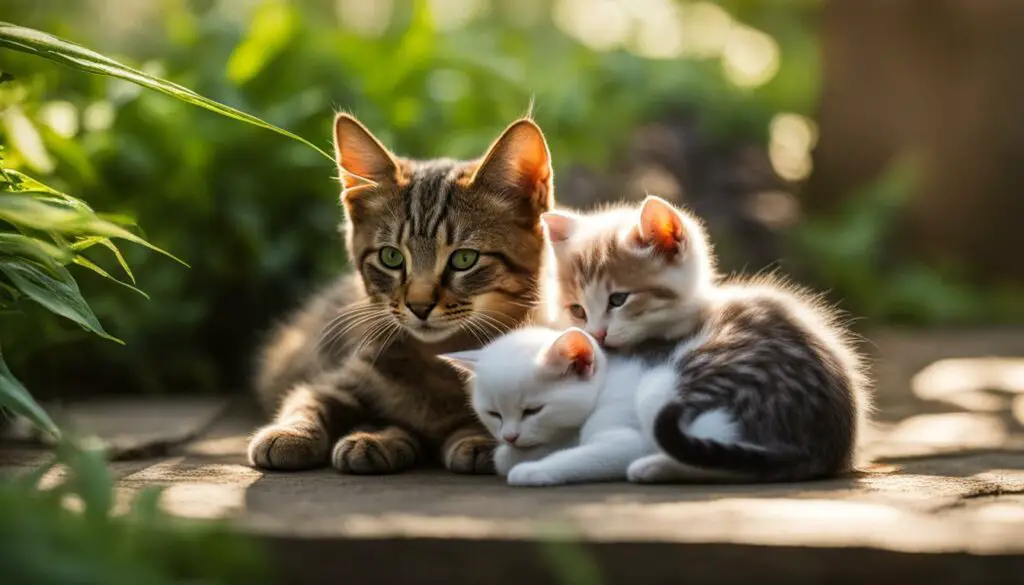
Don’t Take Kittens or Their Mother to an Animal Shelter
If you come across stray kittens or a mother cat outdoors, it might be tempting to take them to an animal shelter for help. However, it’s important to understand that most shelters do not have specialized programs to provide the specific care that unweaned kittens need.
Bringing kittens to a shelter can put their lives at risk. There is a possibility that they may be euthanized due to limited resources and capacity. Moreover, the shelter environment can be stressful for mother cats, which can negatively impact their health and ability to care for their kittens.
Additionally, the immune systems of young kittens are not fully developed, making them susceptible to diseases that are common in shelter settings. It’s best to avoid exposing them to these risks and instead consider alternative options for their care.
Here are some alternative options to consider:
- Reach out to local animal welfare organizations or rescue groups that have experience in fostering and caring for young kittens.
- Explore Trap-Neuter-Return (TNR) programs that focus on spaying or neutering feral cats and returning them to their outdoor homes.
- Provide a safe and secure outdoor area for the mother cat and kittens, ensuring they have access to food, water, and shelter.
By opting for these alternatives, you can help ensure the well-being and safety of the mother cat and her kittens without putting them at risk in an animal shelter.
| Advantages of Alternative Options | Disadvantages of Taking Kittens to an Animal Shelter |
|---|---|
| Specialized care for unweaned kittens | Risk of euthanasia |
| Reduced stress for mother cat | Impact on mother cat’s ability to care for kittens |
| Minimized exposure to shelter diseases | Limited resources and capacity for young kittens |
Remember, the goal is to ensure the best possible outcome for the mother cat and her kittens. Taking them to an animal shelter may not provide the specialized care they need, so it’s essential to explore alternative options that prioritize their well-being.

I. What To Do If You Find a Kitten
If you come across a kitten outdoors, it’s important to assess its age and situation to determine the best course of action. Here are some steps you can take to provide help for young kittens:
I.1 Assess the Age and Independence of the Kitten
First, try to determine the age of the kitten. This will help you understand its needs and whether it is still dependent on its mother. If the kitten is 8 weeks old or older and appears to be weaned from its mother, you can consider taking it to a veterinary clinic for spaying or neutering.
I.2 Consider the Presence of the Mother
Take a close look around to see if the kitten’s mother is nearby. If the mother is present and the kittens appear healthy and well-cared for, it’s best to leave them be. Mother cats are instinctively equipped to care for their young, and separating them can cause unnecessary stress and harm.
I.3 Explore Adoption or Foster Options
If the mother is not present or the kittens are in immediate danger, you may need to intervene. In such cases, consider reaching out to local animal welfare organizations or shelters to explore adoption or foster options. These organizations have the resources and expertise to provide the care and support that young kittens need.
Remember, finding kittens outdoors can be a concerning situation, but by assessing their needs and seeking appropriate help, you can make a positive impact on their well-being.
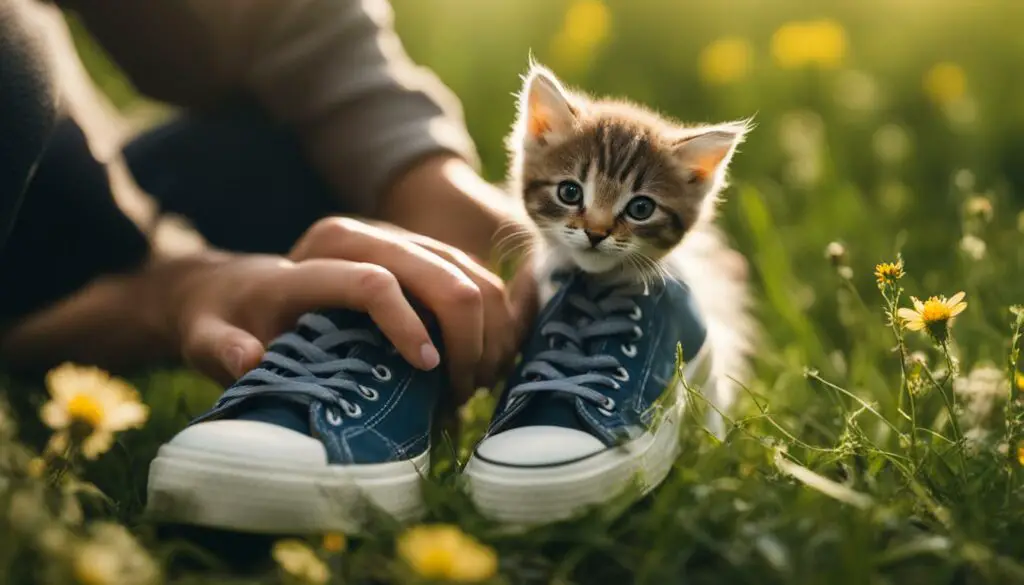
Kittens Younger than 8 Weeks WITH Their Mother
If you come across kittens outdoors who are younger than 8 weeks old and they are accompanied by their mother, it is important to refrain from intervening. These kittens are in the care of their mother, who is instinctively equipped to provide for their needs. Attempting to rescue or remove the kittens from their mother can be detrimental to their well-being. Instead, focus on providing a safe and comfortable environment for the mother cat as she cares for her young.
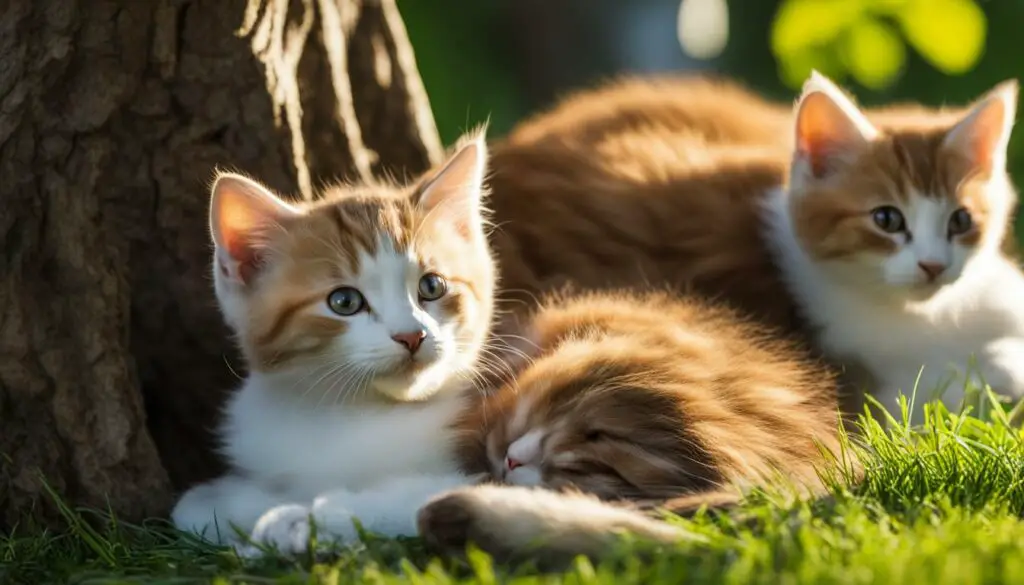
Ensuring that the mother cat has access to regular food and water is essential for her to adequately nourish her kittens. It is also beneficial to provide an outdoor shelter where the mother cat can protect her offspring from the elements. By creating a conducive environment for the mother cat, you are supporting her ability to care for her kittens and giving them the best chance of survival.
Benefits of Leaving Kittens with Their Mother:
- The mother cat is the best caregiver for the kittens, providing them with nutrition, warmth, and security.
- The kittens will have the opportunity to develop important social and behavioral skills from their mother.
- The mother cat’s milk provides essential antibodies that boost the kittens’ immune systems, protecting them from diseases.
- Removing the kittens from their mother can cause distress and anxiety for both the mother and the kittens.
By allowing the mother cat to care for her kittens, you are respecting the natural bond between them and giving them the best chance at a healthy and happy life. It is important to monitor their well-being from a distance and seek professional help if any signs of danger or distress arise.
What if the Kittens Are in Danger?
If you come across stray kittens that are in immediate danger, it is crucial to take swift action to ensure their safety. There are various situations where kittens may be at risk, such as being in a flooded area or near a fire. In such cases, moving them to another safe outdoor spot as close to their original nest as possible can be the best course of action. This allows the mother cat to easily locate them and continue caring for them.

However, if you believe that the mother and kittens are in more long-term danger, such as extreme weather conditions or a disaster scenario, it may be necessary to bring them inside. Creating a quiet, small room or using a large dog crate as a temporary shelter can provide them with a safe haven. This gives the kittens and their mother protection from the elements and ensures their well-being until a suitable solution can be found.
It’s important to keep in mind that the safety and welfare of the kittens should always be the top priority. Assess the situation carefully and make decisions based on what is in the best interest of the kittens and their mother. Seeking help from animal welfare organizations or experienced individuals can also provide valuable guidance and support in ensuring the kittens’ safety.
Once Kittens are 8 Weeks Old: Spay or Neuter
Once kittens reach 8 weeks old and are weaned from their mother, it is ideal to have them spayed or neutered. This important procedure helps ensure their long-term health and wellbeing. Spaying or neutering kittens not only prevents unwanted pregnancies but also reduces the risk of certain diseases and behavioral issues later in life. By spaying or neutering kittens, we can contribute to controlling the stray cat population and promoting responsible pet ownership.
Spaying refers to the surgical removal of a female cat’s reproductive organs, while neutering is the removal of a male cat’s testicles. Both procedures are safe and commonly performed by veterinarians. Spaying or neutering kittens at 8 weeks old is recommended because it is the age at which they can safely undergo anesthesia and recover quickly. It also ensures that they will not contribute to the cycle of stray kittens by reproducing when they reach sexual maturity.
Spaying or neutering kittens is not only beneficial for their individual health but also for the overall welfare of the cat population. By preventing unwanted litters, we can help reduce the number of stray and feral cats that face challenges in finding adequate food, shelter, and healthcare. It also helps alleviate the strain on animal shelters and rescue organizations, allowing them to focus their resources on providing care for cats in need.
| Benefits of Spaying or Neutering Kittens | Examples of Benefits |
|---|---|
| Prevents unwanted pregnancies | Reduces the number of stray and feral cats |
| Reduces the risk of certain diseases | Decreases the likelihood of mammary gland tumors in female cats |
| Eliminates or reduces behavioral issues | Decreases the urge to roam, spray urine, and exhibit aggressive behaviors in male cats |
I strongly believe that spaying and neutering kittens at 8 weeks old is a responsible and compassionate choice. By taking this proactive step, we can help create a healthier and more sustainable future for cats. Let’s work together to prevent unplanned litters and ensure that every kitten has the opportunity to lead a happy and healthy life.
Importance of Early Spaying and Neutering
Early spaying and neutering of kittens at 8 weeks old has several advantages. It is a proactive approach to preventing unwanted litters and helps reduce the risk of reproductive-related health issues. Spaying female kittens before their first heat cycle significantly reduces the risk of mammary gland tumors, which can be malignant in cats. Neutering male kittens prevents testicular cancer and reduces the risk of prostate problems later in life. Early spaying and neutering also eliminates the behavioral issues associated with intact cats, such as spraying, aggression, and the urge to wander in search of a mate.
Kittens Younger than 8 Weeks WITHOUT Their Mother
If you come across kittens that are younger than 8 weeks old and without their mother, it is crucial to take action quickly. These kittens are vulnerable and require special care and attention to ensure their survival. Stabilizing their health should be your first priority. Provide them with a warm and safe environment where they can be protected from the elements.
Seek help from an animal welfare organization or shelter in your area. They will have the expertise and resources to guide you on how to care for the abandoned kittens properly. These organizations can provide advice on feeding guidelines and offer assistance with medical care if needed.
Remember, abandoned kittens are entirely dependent on humans for their survival. By acting promptly and providing them with the care they need, you can make a significant difference in their lives. Every abandoned kitten deserves a chance at a happy and healthy future.
Key Points:
- Kittens younger than 8 weeks old without their mother require special care and attention.
- Stabilize their health and provide them with a warm and safe environment.
- Seek help from an animal welfare organization or shelter for guidance and assistance.
“Taking action quickly is crucial when you find kittens younger than 8 weeks old without their mother. These vulnerable kittens require special care and attention for their survival. Provide them with a warm and safe environment, and seek help from an animal welfare organization or shelter.”
Table: Care Guidelines for Abandoned Kittens Younger than 8 Weeks
| Guidelines | Description |
|---|---|
| Stabilize their health | Ensure the kittens are in good health and provide any necessary medical care. |
| Warm and safe environment | Provide them with a comfortable space protected from the elements. |
| Feeding guidelines | Follow proper feeding guidelines for their age and consult with experts if needed. |
| Seek help from animal welfare organizations | Get guidance and assistance from professionals who specialize in caring for abandoned kittens. |

Your Immediate Role in Helping Abandoned or Sick Kittens
When it comes to abandoned or sick kittens, your immediate role is crucial in providing them with the care they need. Acting quickly and creating a warm and safe environment is essential for their well-being. Assessing their overall health and seeking help from an animal welfare organization or shelter can provide the necessary support to ensure their survival.
Feeding the kittens carefully is a vital part of their care. It is important to follow proper feeding guidelines for their age, ensuring they receive the nutrition they need to grow and thrive. For abandoned kittens, this may involve using a kitten formula and bottle-feeding them until they are old enough to eat solid food.

In addition to immediate care, it is important to monitor the kittens’ health and look for any signs of illness or distress. Contacting a veterinarian for guidance is recommended, as they can provide specific advice and treatment options for sick kittens.
Remember, providing abandoned or sick kittens with a warm and safe environment, appropriate nutrition, and veterinary care are key factors in giving them the best chance of survival and finding them a loving forever home.
How Old are the Kittens?
Assessing the age of kittens is crucial in determining the appropriate care and next steps. Kittens go through different developmental stages and have specific needs at each stage. By understanding the age of the kittens, you can provide them with the best possible care and ensure their overall well-being.
One way to assess the age of kittens is by observing their physical characteristics and behavior. Newborn kittens, for example, have their eyes closed and ears folded, while older kittens have their eyes open and ears erect. Additionally, their mobility and coordination improve as they grow older.
Another method to determine the age of kittens is by comparing their weight and size to standard growth charts. By weighing and measuring them regularly, you can track their progress and identify their approximate age range. This information is valuable in determining the appropriate feeding schedule and socialization opportunities for the kittens.

It’s important to note that accurately determining the age of kittens can be challenging, especially if they were found without their mother. In such cases, it’s recommended to consult with a veterinarian or an experienced animal welfare professional who can provide expert guidance based on their knowledge and experience.
Don’t Forget the Big Picture: Prevention
When it comes to addressing the issue of stray kittens, it’s crucial to remember the importance of prevention. By taking proactive measures, we can help reduce the number of stray kittens in our communities and ensure their well-being. One of the most effective ways to prevent stray kittens is through spaying or neutering cats.
Spaying or neutering cats not only prevents unwanted litters, but it also has numerous health benefits for the cats themselves. It helps reduce the risk of certain cancers and can eliminate behavioral issues related to mating behaviors. By spaying or neutering cats, we can prevent the cycle of stray kittens from continuing.
Community outreach plays a vital role in preventing stray kittens as well. Educating ourselves and others about the benefits of spaying or neutering, as well as the importance of responsible pet ownership, can make a significant impact. By reaching out to our neighbors, local organizations, and schools, we can raise awareness and promote responsible cat ownership.
| Benefits of Spaying or Neutering Cats | Importance of Community Outreach |
|---|---|
| – Prevents unwanted litters | – Educate about spaying/neutering |
| – Reduces the risk of certain cancers | – Promote responsible pet ownership |
| – Eliminates behavioral issues | – Raise awareness in schools |
Prevention is the key to reducing the number of stray kittens in our communities. By spaying or neutering cats and engaging in community outreach, we can make a positive impact and ensure a better future for all cats.
It’s important to remember that every little step we take towards prevention can have a significant impact. Whether it’s supporting local spay/neuter programs, advocating for cat welfare, or simply spreading the word about responsible pet ownership, each action brings us closer to a world with fewer stray kittens.

Learn, Then Share: Become an Advocate for Cats
When it comes to helping stray kittens, education and spreading awareness are key. By learning about cat advocacy, spay/neuter education, and community outreach, you can make a difference in the lives of cats and prevent future generations of stray kittens from being born.
One way to become an advocate for cats is to educate yourself about the importance of spaying or neutering pets. This can help prevent unwanted litters and reduce the number of stray kittens in your community. You can also familiarize yourself with local spay/neuter programs and resources that offer affordable or free services. By sharing this information with others, you can encourage responsible pet ownership and help reduce the stray cat population.
Community outreach is another important aspect of cat advocacy. This can involve organizing spay/neuter events, hosting educational workshops, or volunteering at local animal shelters or rescue organizations. By actively engaging with your community, you can raise awareness about the benefits of spaying and neutering, provide resources for pet owners in need, and promote the importance of responsible cat care.
Remember, every action makes a difference. By becoming an advocate for cats and sharing your knowledge and passion with others, you can help create a better future for stray kittens and cats in need.
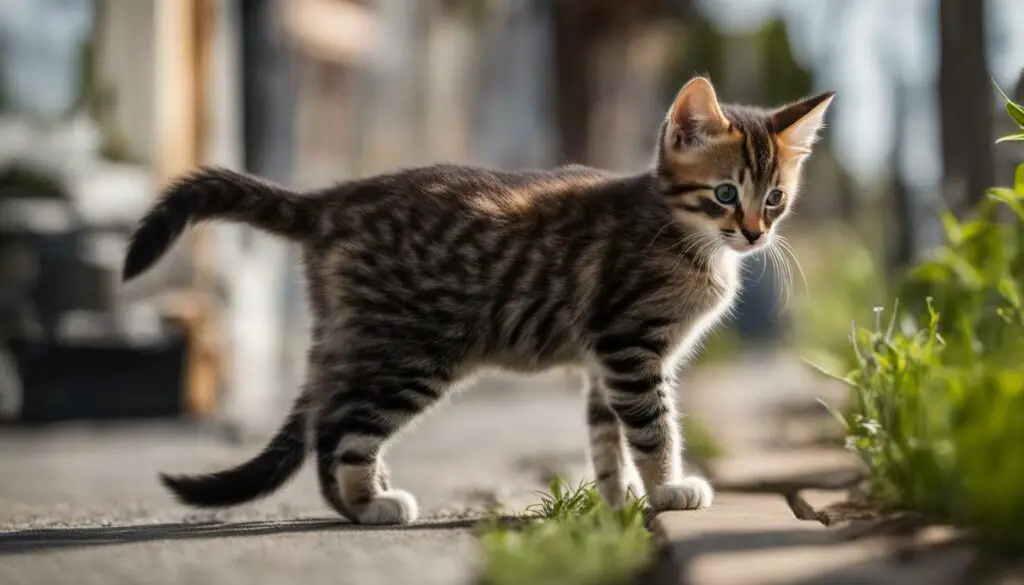
Neighborhood Search: Locating Stray Kittens
When it comes to finding stray kittens, the first place to start is right in your own neighborhood. By thoroughly exploring your immediate area, you can increase your chances of locating these lost little ones. Begin by searching your own home and property, paying attention to common hiding spots such as decks, porches, garages, and sheds. Kittens are often drawn to these secluded areas for safety.
Don’t hesitate to ask for help from friends, neighbors, and fellow animal lovers in your community. They may have valuable information or be willing to join in the search effort. By working together, you can cover more ground and increase your chances of success.
Utilizing technology can also be a game-changer in your search for stray kittens. Motion-activated cameras strategically placed in your neighborhood can provide valuable clues about the whereabouts of these elusive creatures. Additionally, spreading the word through social media platforms, such as community Facebook groups, can help reach a wider audience and increase the chances of someone spotting the kittens.
Table: Common Hiding Spots for Stray Kittens in the Neighborhood
| Hiding Spot | Description |
|---|---|
| Decks | Kittens might find refuge under decks or other raised structures, away from predators and inclement weather. |
| Porches | Stray kittens often seek shelter on porches, taking advantage of the protection provided by overhangs. |
| Garages | Warm and secure, garages are enticing spots for stray kittens to seek refuge. |
| Sheds | Quiet and secluded, sheds can serve as makeshift homes for stray kittens. |
Remember, it’s important to approach your search for stray kittens with patience and perseverance. These vulnerable creatures may be scared and cautious, so it may take time to gain their trust. By employing a combination of traditional search methods and technological resources, you can increase the likelihood of finding these lost kittens and providing them with the care they need.

Spread the Word: Engaging the Community in the Search
When it comes to finding stray kittens, spreading the word and engaging the community plays a crucial role in increasing the chances of locating them. By reaching out to your neighbors and utilizing various communication channels, you can create a network of individuals who are actively involved in the search.
One effective method is to hang lost cat posters in your neighborhood. These posters should include a clear photo of the kittens, a brief description, and your contact information. Placing them in prominent areas, such as community bulletin boards or local businesses, can help raise awareness and prompt people to keep an eye out for the kittens.
Social media platforms can also be powerful tools for spreading the word. Share the details of the stray kittens on local community groups and pet-related forums. Encourage others to share the information to reach a wider audience. Remember to include relevant hashtags and location tags to increase visibility. Sharing heartwarming stories or updates about the search can generate interest and engagement from the community.
| Engaging the Community in the Search | Benefits |
|---|---|
| Hang lost cat posters | Increases awareness within the neighborhood |
| Utilize social media platforms | Reaches a wider audience and encourages sharing |
| Knock on doors and alert neighbors | Involves the community directly and provides valuable information |

A more personal approach is to knock on doors and alert your neighbors about the missing kittens. Explain the situation and provide them with any relevant information, such as the kittens’ description and where they were last seen. Neighbors who are familiar with the area might have spotted them or can provide helpful insights.
Engaging the community in the search effort can significantly increase the chances of finding stray kittens. By spreading the word through lost cat posters, utilizing social media platforms, and actively involving your neighbors, you create a network of support and increase the likelihood of a successful reunion.
Alerting Authorities and Using Online Resources
When all efforts to locate stray kittens in your neighborhood have been exhausted, it is crucial to alert the appropriate authorities and utilize online resources to maximize your chances of finding them. Start by contacting local animal shelters and animal control agencies to report the kittens as lost. Submitting detailed lost cat reports will help ensure that the kittens are registered and that their information is readily available to those who may have found them.
Online resources can also play a significant role in your search for stray kittens. Utilize social media platforms, such as Facebook groups dedicated to lost and found pets, to spread the word about the missing kittens. Posting pictures and descriptions can help engage the community and increase the chances of someone recognizing the kittens and providing information about their whereabouts.
Additionally, there are dedicated online databases and community forums where you can post information about the lost kittens. These platforms allow you to reach a wider audience and connect with individuals who may have encountered the kittens or have helpful information. Remember to provide detailed descriptions, including any distinguishing features, and include your contact information so that those who have seen the kittens can reach out to you directly.

Online Search Tips
- Utilize social media platforms to spread the word about the missing kittens
- Post pictures and descriptions of the kittens to engage the community
- Use dedicated online databases and community forums to reach a wider audience
- Provide detailed descriptions, including any distinguishing features
- Include your contact information to encourage direct communication
By alerting authorities and harnessing the power of online resources, you can increase your chances of locating the stray kittens. Remember to remain proactive and persistent in your search efforts while maintaining open lines of communication with local animal welfare organizations and the community.
Conclusion
In conclusion, when it comes to finding stray kittens, it’s important to approach the situation with care and consideration for their well-being. The best course of action is to leave kittens with their mother if possible, as she is equipped to provide the best care for them. However, there are circumstances where intervention may be necessary, such as when the kittens are in immediate danger or the mother is absent.
It is crucial to remember that most animal shelters do not have the resources to provide the specialized care that young, unweaned kittens require. Taking them to a shelter can put their lives at risk and negatively impact their health. Instead, consider reaching out to animal welfare organizations for guidance and support.
Additionally, prevention is key in reducing the number of stray kittens in the long run. Spaying or neutering cats is an effective way to prevent unwanted litters and the cycle of stray kittens. Educating yourself and others about the importance of spaying or neutering can help create a more compassionate and responsible community.
In summary, by leaving kittens with their mother if possible, seeking appropriate help when needed, and advocating for prevention, we can ensure the well-being of stray kittens and work towards a future where they are not left to fend for themselves on the streets.
FAQ
Where are common places to find stray kittens?
Common places to find stray kittens include under decks, in porches, garages, sheds, and other hidden spots.
What should I do if I find kittens outdoors?
If the kittens are with their mother and appear healthy, it is best to leave them be and allow the mother cat to care for them. If the kittens are younger than 8 weeks old and without their mother, they may require intervention and special care.
Can I take stray kittens or their mother to an animal shelter?
It is not recommended to take stray kittens or their mother to an animal shelter, as most shelters do not have programs to provide the specific care unweaned kittens need. Shelters can also be stressful environments for mother cats and can negatively impact their ability to care for the kittens.
What should I do if I find a kitten?
If you find a kitten outdoors, it is important to assess their age and situation. If the kitten is 8 weeks old or older and weaned from their mother, you can consider taking them to a veterinarian for spay or neuter. If the kitten is younger and with their mother, it is best to leave them be unless they are in immediate danger.
How should I help kittens younger than 8 weeks old with their mother outdoors?
If you find kittens younger than 8 weeks old with their mother outdoors, it is best to leave them be. Mother cats are instinctively equipped to care for their kittens, and it is best not to interfere unless they are in immediate danger.
What should I do if the kittens are in immediate danger?
If you believe the kittens are in immediate danger, such as a flooded area or close to a fire, you may need to move them to another safe outdoor spot as close to their original nest as possible. This will allow the mother cat to find them.
When should I have kittens spayed or neutered?
It is ideal to have kittens spayed or neutered when they reach 8 weeks old and are weaned from their mother. Spaying or neutering helps ensure their health and wellbeing.
What should I do if I find kittens younger than 8 weeks old without their mother?
If you find kittens younger than 8 weeks old without their mother, and you believe they are abandoned or in distress, it is important to act quickly. Stabilize their health, seek help from an animal welfare organization or shelter, and provide appropriate feeding and care.
How can I determine the age of the kittens?
Determining the age of the kittens is crucial in determining the appropriate care. Kittens go through developmental stages and have different needs at each stage. Knowing their approximate age will help guide your decisions and ensure they receive the proper care.
How can I prevent stray kittens in the future?
Educating yourself and others about the benefits of spaying or neutering cats, canvassing your neighborhood to gather information, and advocating for spay/neuter programs are important steps in preventing the cycle of stray kittens.
How can I become an advocate for cats?
Taking the time to educate yourself about cat care and spay/neuter programs, and sharing that knowledge with others, can make a significant impact. Becoming an advocate for cats and spreading awareness about the importance of spaying or neutering can help prevent future generations of stray kittens.
How can I search for stray kittens in my neighborhood?
Start your search by thoroughly exploring your immediate area, including your own home and property. Ask for help from friends and neighbors, and check common hiding spots like decks, porches, garages, and sheds.
How can I engage my community in the search for stray kittens?
Engage your community by knocking on doors, hanging lost cat posters, and alerting people who regularly visit your neighborhood. Utilize local social media groups and missing pet registries to spread the word.
What should I do if I can’t find stray kittens in my neighborhood?
If your search for stray kittens is unsuccessful, it is important to alert local animal shelters and animal control agencies. Submitting lost reports and ensuring the kittens are registered as lost can aid in the search efforts.
What are online resources I can use to locate stray kittens?
Utilize online resources such as Facebook groups, online databases, and community forums to help in the search for stray kittens. Facial recognition databases can also aid in the search efforts.
Is there a conclusion to this guide?
This guide provides information on common places to find stray kittens, how to help them, and how to prevent their population growth. By following these tips and seeking help from animal welfare organizations, we can make a positive impact on the lives of stray kittens.

